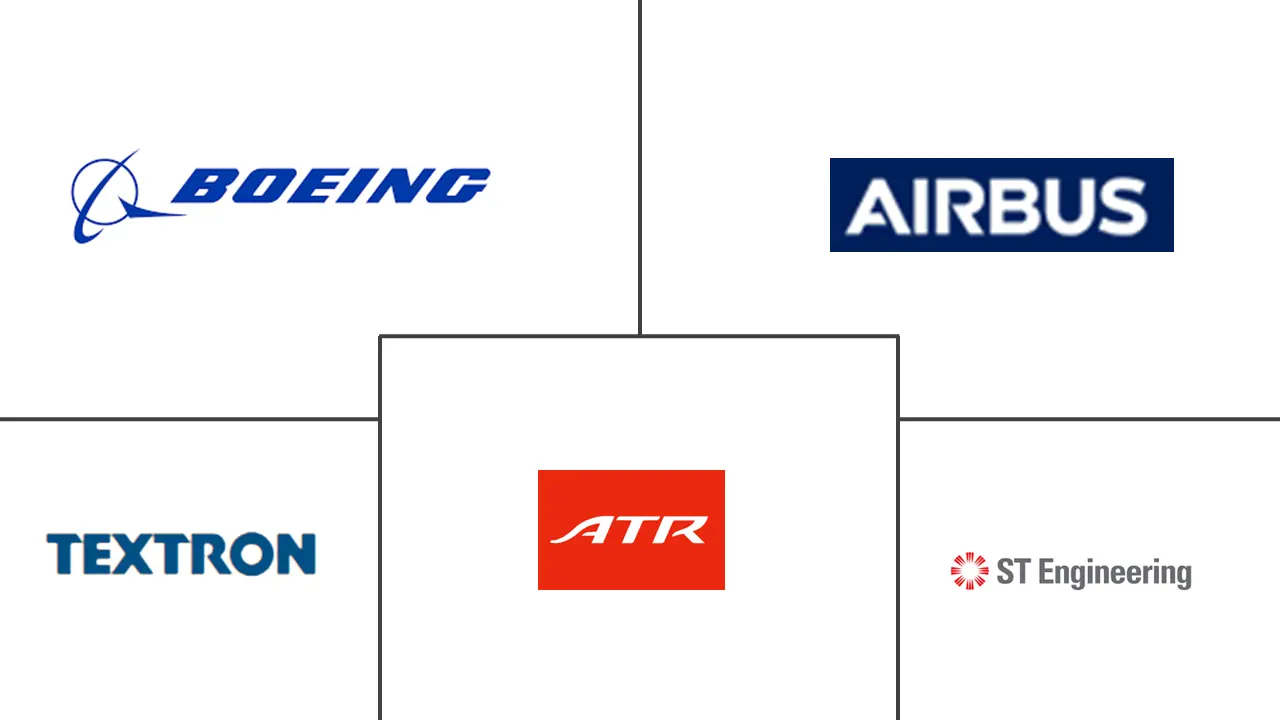Freighter Aircraft Market Size & Share Analysis – Growth Trends & Forecasts (2025 – 2030)
The Freighter Aircraft Market Report is Segmented by Aircraft Type (Dedicated Cargo Aircraft and Derivative of Non-Cargo Aircraft), Engine Type (Turboprop Aircraft and Turbofan Aircraft), and Geography (North America, Europe, Asia-Pacific, Latin America, and the Middle East and Africa). The Report Offers Market Size and Forecast for all the Above Segments in Value (USD).
Freighter Aircraft Market Size & Share Analysis – Growth Trends & Forecasts (2025 – 2030)
Freighter Aircraft Market Size
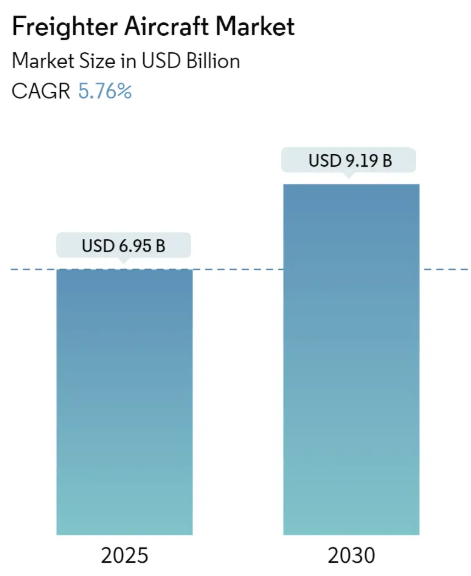
| Study Period | 2019 – 2030 |
| Market Size (2025) | USD 6.95 Billion |
| Market Size (2030) | USD 9.19 Billion |
| CAGR (2025 – 2030) | 5.76 % |
| Fastest Growing Market | Asia Pacific |
| Largest Market | North America |
| Market Concentration | High |
Major Players
*Disclaimer: Major Players sorted in no particular order |
Compare market size and growth of Freighter Aircraft Market with other markets in Aerospace & Defense Industry
Defense
Airport Operations
Aviation
Aerospace & Defense Technology
Air Taxi
Aircraft Parts
Freighter Aircraft Market Size & Share Analysis – Growth Trends & Forecasts (2025 – 2030)
| Study Period: | 2019 – 2030 |
| CAGR: | 5.76% (2025 – 2030) |
| Countries/ Region Covered: | North America, Europe, Asia Pacific, Latin America, Middle East and Africa |
| Major Players: | The Boeing Company, Airbus SE, Textron Inc., ATR, Singapore Technologies Engineering Ltd. |
Freighter Aircraft Market Analysis
The Freighter Aircraft Market size is estimated at USD 6.95 billion in 2025, and is expected to reach USD 9.19 billion by 2030, at a CAGR of 5.76% during the forecast period (2025-2030).
The rise in new trade relationships among countries and rapid growth in global e-commerce activities primarily drive the freighter aircraft market’s demand. The increased demand for air cargo also leads to a growing demand for freighter aircraft worldwide.
Globally, governments have formed various rules or policies to ensure smoother freighter operations. Although some freighter operators have adhered to the guidelines, many still need to comply, which can hamper freighter operations during the forecast period. The latest trends, such as an increasing focus on digitization and sustainability, air freight as an omnichannel, increasing freighter aircraft capacity, and increasing the price of consignment, are also expected to boost market growth.
Freighter Aircraft Market Trends
The Derivative of the Non-cargo Aircraft Segment is Anticipated to Register the Highest Growth during the Forecast Period
The derivative of the non-cargo aircraft segment is expected to showcase the highest growth during the forecast period. The growth is anticipated due to the rising preference of airlines to modify and update their old passenger aircraft with freighter aircraft to meet the rising volume of air cargo. Increasing passenger-to-freighter conversions is expected to act as a solution for the air cargo capacity constraints due to the increased demand driven by the e-commerce business. The converted passenger aircraft will carry lighter, more voluminous cargo like e-commerce packages. During such conversions, changes are made to the aircraft’s ventilation, fire detection, and temperature control systems because the freighter aircraft have different requirements than passenger aircraft and must comply with other standards.
Some major passenger-to-freighter (P2F) aircraft programs are Boeing B757, B737, and Airbus A321 and A320. Due to the increased demand for new freighters, Astral Aviation announced it would operate the first-ever Airbus A320 passenger-to-freighter (P2F) converted aircraft. IAI also plans to open a new facility with Sharp Technics at South Korea’s Incheon Airport in 2024 to convert Boeing B777s. Such developments worldwide are expected to drive the market’s growth in the coming years.
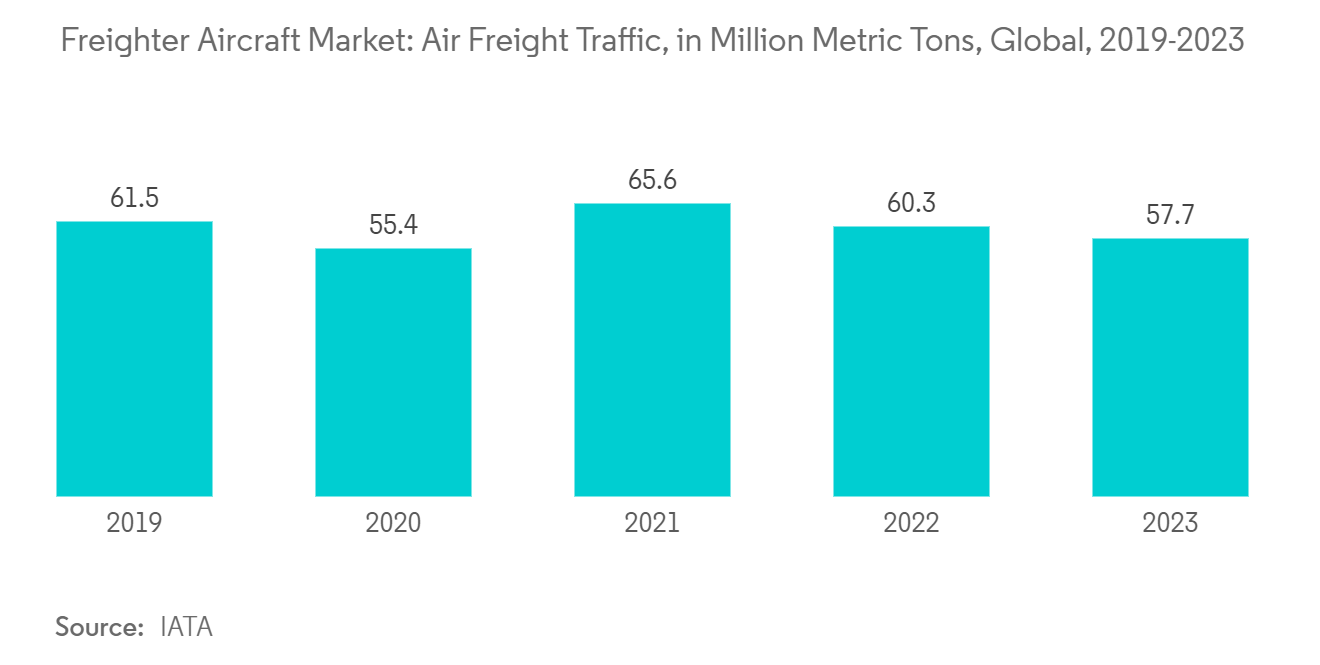
Asia-Pacific is Expected to Showcase Remarkable Growth during the Forecast Period
Asia-Pacific is expected to record the highest CAGR in the coming years. The rising demand for air cargo is mainly due to the region’s increasing e-commerce demand. The growing preference for online shopping and production facilities for electronics systems and other commercial goods in China, India, Japan, Cambodia, and Vietnam drives the market’s growth.
The Chinese domestic aviation market drives the demand for narrow-body aircraft, making them more prevalent for freighter operations. Rising passenger traffic and the expected revival in global air traffic have poised aircraft original equipment manufacturers (OEMs) to procure aircraft in their fleet to meet the anticipated rising demand in coming years. For instance, in May 2023, Chengdu-based Sichuan Airlines received its first Airbus A330-300 passenger-to-freighter (P2F) conversion to increase its cargo fleet to four aircraft.
E-commerce companies in the region benefit from high urban density, a developed economy, and technically savvy customers, further attracting the e-commerce market across the region. Narita International Airport was the Japanese airport handling the most international freight. For instance, in May 2023, JAL announced that it would launch three Boeing B767-300ER aircraft from its passenger fleet and send them to an airframe overhaul facility for conversion into pure freighters that can carry large containers on the main deck. Thus, growing demand for freighters and rising air cargo transportation boost the market’s growth across Asia-Pacific.
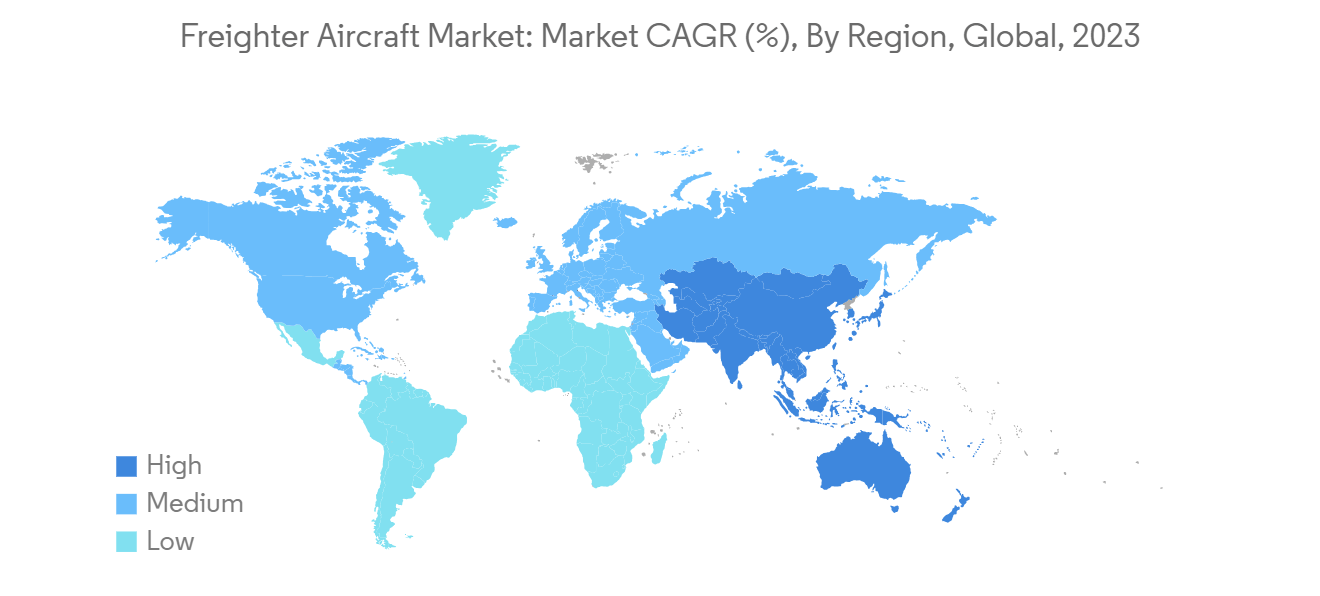
Freighter Aircraft Industry Overview
The freighter aircraft market is consolidated, with aircraft OEMs, third-party contractors or independent companies that enter cooperation agreements with OEMs, and third-party contractors developing their conversion solutions independently. The Boeing Company, Airbus SE, ATR, Singapore Technologies Engineering Ltd, and Textron Inc. are prominent players in the market.
In November 2021, Airbus launched the A350 Freighter program with a seven-aircraft order from Air Lease Corporation. In December 2021, three airlines, including CMA CGM Air Cargo, Air France, and Singapore Airlines, placed orders for the A350F. The aircraft’s deliveries are scheduled during the forecast period. Companies like Boeing, Singapore Technologies Engineering Ltd, IAI, and Precision Aircraft Solution are additional players providing conversion services.
Freighter Aircraft Market Leaders
- The Boeing Company
- Airbus SE
- Textron Inc.
- ATR
- Singapore Technologies Engineering Ltd.
- *Disclaimer: Major Players sorted in no particular order
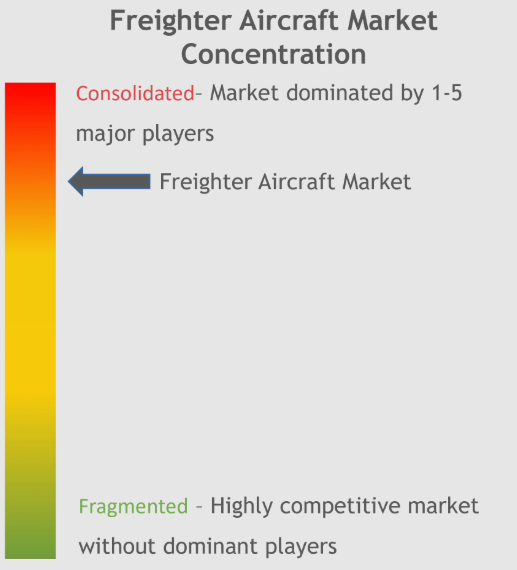
Freighter Aircraft Market News
June 2023: BBN Airlines launched the first Airbus A321 Passenger-to-Freighter converted cargo aircraft to Turkey. With this addition of the converted freighter, BBN Airlines’ Turkish subsidiary now has five aircraft.
January 2023: Mountain Cargo, a FedEx feeder airline, announced it had become the first to operate Textron Aviation’s new Cessna SkyCourierfreighter. Moreover, Textron Inc. delivered the first 50 Cessna SkyCouriertwin utility turboprop freighters to FedEx Express.
Freighter Aircraft Market Report – Table of Contents
1. INTRODUCTION
- 1.1 Study Assumptions
- 1.2 Scope of the Study
2. RESEARCH METHODOLOGY
3. EXECUTIVE SUMMARY
4. MARKET DYNAMICS
- 4.1 Market Overview
- 4.2 Market Drivers
- 4.3 Market Restraints
- 4.4 Porter’s Five Forces Analysis
- 4.4.1 Threat of New Entrants
- 4.4.2 Bargaining Power of Buyers/Consumers
- 4.4.3 Bargaining Power of Suppliers
- 4.4.4 Threat of Substitute Products
- 4.4.5 Intensity of Competitive Rivalry
5. MARKET SEGMENTATION
- 5.1 Aircraft Type
- 5.1.1 Dedicated Cargo Aircraft
- 5.1.2 Derivative of Non-cargo Aircraft
- 5.2 Engine Type
- 5.2.1 Turboprop Aircraft
- 5.2.2 Turbofan Aircraft
- 5.3 Geography
- 5.3.1 North America
- 5.3.1.1 United States
- 5.3.1.2 Canada
- 5.3.2 Europe
- 5.3.2.1 Germany
- 5.3.2.2 United Kingdom
- 5.3.2.3 France
- 5.3.2.4 Russia
- 5.3.2.5 Rest of Europe
- 5.3.3 Asia-Pacific
- 5.3.3.1 China
- 5.3.3.2 India
- 5.3.3.3 Japan
- 5.3.3.4 South Korea
- 5.3.3.5 Rest of Asia-Pacific
- 5.3.4 Latin America
- 5.3.4.1 Brazil
- 5.3.4.2 Rest of Latin America
- 5.3.5 Middle East and Africa
- 5.3.5.1 United Arab Emirates
- 5.3.5.2 Saudi Arabia
- 5.3.5.3 Turkey
- 5.3.5.4 Rest of Middle East and Africa
6. COMPETITIVE LANDSCAPE
- 6.1 Vendor Market Share
- 6.2 Company Profiles
- 6.2.1 The Boeing Company
- 6.2.2 Airbus SE
- 6.2.3 Textron Inc.
- 6.2.4 ATR
- 6.2.5 Air Transport Services Group Inc.
- 6.2.6 KF Aerospace
- 6.2.7 Singapore Technologies Engineering Ltd
- 6.2.8 Aeronautical Engineers Inc.
- 6.2.9 Precision Aircraft Solutions
- 6.2.10 Israel Aerospace Industries Ltd
7. MARKET OPPORTUNITIES AND FUTURE TREND
Freighter Aircraft Industry Segmentation
A freighter or cargo aircraft is designed or converted for transportation of cargo rather than passengers. These aircraft types usually do not carry passengers and feature one or more large doors for loading cargo. They are operated by cargo airlines, civil passengers, private individuals, or the armed forces of individual countries.
The freighter aircraft market is segmented by aircraft type, engine type, and geography. By aircraft type, the market is segmented into dedicated cargo aircraft and derivative of non-cargo aircraft. By engine type, it is segmented into turboprop and turbofan. The report also offers the market size and forecasts for the freighter aircraft market in major countries across different regions. For each segment, the market size is provided in terms of value (USD).
| Aircraft Type | Dedicated Cargo Aircraft | |
| Derivative of Non-cargo Aircraft | ||
| Engine Type | Turboprop Aircraft | |
| Turbofan Aircraft | ||
| Geography | North America | United States |
| Canada | ||
| Geography | Europe | Germany |
| United Kingdom | ||
| France | ||
| Russia | ||
| Rest of Europe | ||
| Geography | Asia-Pacific | China |
| India | ||
| Japan | ||
| South Korea | ||
| Rest of Asia-Pacific | ||
| Geography | Latin America | Brazil |
| Rest of Latin America | ||
| Geography | Middle East and Africa | United Arab Emirates |
| Saudi Arabia | ||
| Turkey | ||
| Rest of Middle East and Africa |
Freighter Aircraft Market Research FAQs
The Freighter Aircraft Market size is expected to reach USD 6.95 billion in 2025 and grow at a CAGR of 5.76% to reach USD 9.19 billion by 2030.
In 2025, the Freighter Aircraft Market size is expected to reach USD 6.95 billion.
The Boeing Company, Airbus SE, Textron Inc., ATR and Singapore Technologies Engineering Ltd. are the major companies operating in the Freighter Aircraft Market.
Asia Pacific is estimated to grow at the highest CAGR over the forecast period (2025-2030).
In 2025, the North America accounts for the largest market share in Freighter Aircraft Market.
In 2024, the Freighter Aircraft Market size was estimated at USD 6.55 billion. The report covers the Freighter Aircraft Market historical market size for years: 2019, 2020, 2021, 2022, 2023 and 2024. The report also forecasts the Freighter Aircraft Market size for years: 2025, 2026, 2027, 2028, 2029 and 2030.

